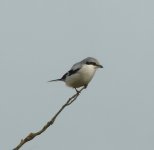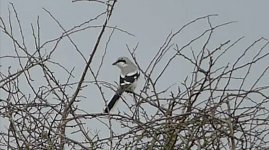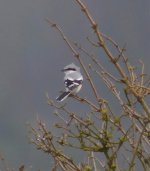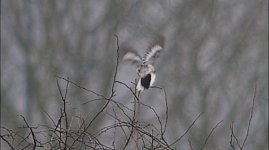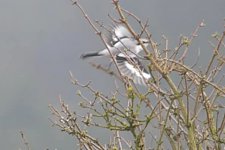mark dowie
Well-known member

All
I would welcome any thoughts on a GGS recently present in SW England
A striking bird at first sight (confirmed by others when drawn to their attention), but failing to draw any real observer comment and presumably regarded as ‘just a great grey shrike’ due to typically distant views &/or lack of close scrutiny
I was able to obtain reasonably close views over a prolonged period of observation, and have attached a number of photos which illustrate (albeit poorly) the following features noted at the time
http://birdingfrontiers.com/2010/11/05/homeyeri-great-grey-shrike/
And I can find few examples of birds revealing such a marked amount of white on the trailing edge to the wing?
Recent publications on GGS taxonomy seem to promote this view of two main variants within the nominate subspecies (and this is supported by close scrutiny of photos taken in the UK with birds showing both limited and extended wing patches) although the position is complicated by significant variation in appearance within forms and the possibility of intergrades or even hybrids in transitional zones across Europe, across to the Ukraine and Western Siberia
I certainly don’t think that this is a homeyeri but the anomalies in plumage stated above (in addition to the extended white patch into the secondaries) would seem worthy of discussion
Any thoughts would be appreciated
M
I would welcome any thoughts on a GGS recently present in SW England
A striking bird at first sight (confirmed by others when drawn to their attention), but failing to draw any real observer comment and presumably regarded as ‘just a great grey shrike’ due to typically distant views &/or lack of close scrutiny
I was able to obtain reasonably close views over a prolonged period of observation, and have attached a number of photos which illustrate (albeit poorly) the following features noted at the time
- Striking appearance notably due to pale appearance and significant amount of visible white on upperparts
- Pale area just above the lores
- Little/no white supercilium stripe above balck mask
- Significant white scapular crescent
- Upperwing white patch at base of primaries continuing without break onto base of secondaries (but sec’y patch not quite as wide)
- Photos reveal no bleeding of white along the edges of the secondaries i.e. spiking towards trailing edge of wing
- Extremely broad white patch on trailing edge to closed wing formed by broad white border to lower tertials and inner secondaries
- Significant white in tail including seemingly white outer tail feather T6
- Noticeably pale(r) rump compared with mantle / back
- Slight white edging to primary tips
- Ash grey underparts with no barring
http://birdingfrontiers.com/2010/11/05/homeyeri-great-grey-shrike/
And I can find few examples of birds revealing such a marked amount of white on the trailing edge to the wing?
Recent publications on GGS taxonomy seem to promote this view of two main variants within the nominate subspecies (and this is supported by close scrutiny of photos taken in the UK with birds showing both limited and extended wing patches) although the position is complicated by significant variation in appearance within forms and the possibility of intergrades or even hybrids in transitional zones across Europe, across to the Ukraine and Western Siberia
I certainly don’t think that this is a homeyeri but the anomalies in plumage stated above (in addition to the extended white patch into the secondaries) would seem worthy of discussion
Any thoughts would be appreciated
M




